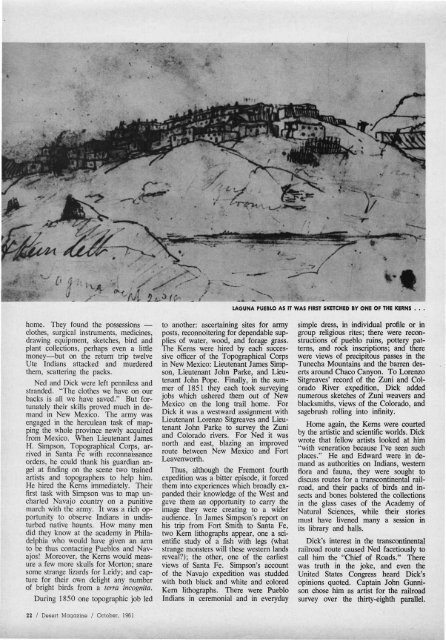OUTDOOR SOUTHWEST - Desert Magazine of the Southwest
OUTDOOR SOUTHWEST - Desert Magazine of the Southwest
OUTDOOR SOUTHWEST - Desert Magazine of the Southwest
You also want an ePaper? Increase the reach of your titles
YUMPU automatically turns print PDFs into web optimized ePapers that Google loves.
home. They found <strong>the</strong> possessions —<br />
clo<strong>the</strong>s, surgical instruments, medicines,<br />
drawing equipment, sketches, bird and<br />
plant collections, perhaps even a little<br />
money—but on <strong>the</strong> return trip twelve<br />
Ute Indians attacked and murdered<br />
<strong>the</strong>m, scattering <strong>the</strong> packs.<br />
Ned and Dick were left penniless and<br />
stranded. "The clo<strong>the</strong>s we have on our<br />
backs is all we have saved." But fortunately<br />
<strong>the</strong>ir skills proved much in demand<br />
in New Mexico. The army was<br />
engaged in <strong>the</strong> herculean task <strong>of</strong> mapping<br />
<strong>the</strong> whole province newly acquired<br />
from Mexico. When Lieutenant James<br />
H. Simpson, Topographical Corps, arrived<br />
in Santa Fe with reconnaissance<br />
orders, he could thank his guardian angel<br />
at finding on <strong>the</strong> scene two trained<br />
artists and topographers to help him.<br />
He hired <strong>the</strong> Kerns immediately. Their<br />
first task with Simpson was to map uncharted<br />
Navajo country on a punitive<br />
march with <strong>the</strong> army. It was a rich opportunity<br />
to observe Indians in undisturbed<br />
native haunts. How many men<br />
did <strong>the</strong>y know at <strong>the</strong> academy in Philadelphia<br />
who would have given an arm<br />
to be thus contacting Pueblos and Navajos!<br />
Moreover, <strong>the</strong> Kerns would measure<br />
a few more skulls for Morton; snare<br />
some strange lizards for Leidy; and capture<br />
for <strong>the</strong>ir own delight any number<br />
<strong>of</strong> bright birds from a terra incognita.<br />
During 1850 one topographic job led<br />
22 / <strong>Desert</strong> <strong>Magazine</strong> / October, 1961<br />
to ano<strong>the</strong>r: ascertaining sites for army<br />
posts, reconnoitering for dependable supplies<br />
<strong>of</strong> water, wood, and forage grass.<br />
The Kerns were hired by each successive<br />
<strong>of</strong>ficer <strong>of</strong> <strong>the</strong> Topographical Corps<br />
in New Mexico: Lieutenant James Simpson,<br />
Lieutenant John Parke, and Lieutenant<br />
John Pope. Finally, in <strong>the</strong> summer<br />
<strong>of</strong> 1851 <strong>the</strong>y each took surveying<br />
jobs which ushered <strong>the</strong>m out <strong>of</strong> New<br />
Mexico on <strong>the</strong> long trail home. For<br />
Dick it was a westward assignment with<br />
Lieutenant Lorenzo Sitgreaves and Lieutenant<br />
John Parke to survey <strong>the</strong> Zuni<br />
and Colorado rivers. For Ned it was<br />
north and east, blazing an improved<br />
route between New Mexico and Fort<br />
Leavenworth.<br />
Thus, although <strong>the</strong> Fremont fourth<br />
expedition was a bitter episode, it forced<br />
<strong>the</strong>m into experiences which broadly expanded<br />
<strong>the</strong>ir knowledge <strong>of</strong> <strong>the</strong> West and<br />
gave <strong>the</strong>m an opportunity to carry <strong>the</strong><br />
image <strong>the</strong>y were creating to a wider<br />
audience. In James Simpson's report on<br />
his trip from Fort Smith to Santa Fe,<br />
two Kern lithographs appear, one a scientific<br />
study <strong>of</strong> a fish with legs (what<br />
strange monsters will <strong>the</strong>se western lands<br />
reveal?); <strong>the</strong> o<strong>the</strong>r, one <strong>of</strong> <strong>the</strong> earliest<br />
views <strong>of</strong> Santa Fe. Simpson's account<br />
<strong>of</strong> <strong>the</strong> Navajo expedition was studded<br />
with both black and white and colored<br />
Kern lithographs. There were Pueblo<br />
Indians in ceremonial and in everyday<br />
LAGUNA PUEBLO AS IT WAS FIRST SKETCHED BY ONE OF THE KERNS .<br />
simple dress, in individual pr<strong>of</strong>ile or in<br />
group religious rites; <strong>the</strong>re were reconstructions<br />
<strong>of</strong> pueblo ruins, pottery patterns,<br />
and rock inscriptions; and <strong>the</strong>re<br />
were views <strong>of</strong> precipitous passes in <strong>the</strong><br />
Tunecha Mountains and <strong>the</strong> barren deserts<br />
around Chaco Canyon. To Lorenzo<br />
Sitgreaves' record <strong>of</strong> <strong>the</strong> Zuni and Colorado<br />
River expedition, Dick added<br />
numerous sketches <strong>of</strong> Zuni weavers and<br />
blacksmiths, views <strong>of</strong> <strong>the</strong> Colorado, and<br />
sagebrush rolling into infinity.<br />
Home again, <strong>the</strong> Kerns were courted<br />
by <strong>the</strong> artistic and scientific worlds. Dick<br />
wrote that fellow artists looked at him<br />
"with veneration because I've seen such<br />
places." He and Edward were in demand<br />
as authorities on Indians, western<br />
flora and fauna, <strong>the</strong>y were sought to<br />
discuss routes for a transcontinental railroad,<br />
and <strong>the</strong>ir packs <strong>of</strong> birds and insects<br />
and bones bolstered <strong>the</strong> collections<br />
in <strong>the</strong> glass cases <strong>of</strong> <strong>the</strong> Academy <strong>of</strong><br />
Natural Sciences, while <strong>the</strong>ir stories<br />
must have livened many a session in<br />
its library and halls.<br />
Dick's interest in <strong>the</strong> transcontinental<br />
railroad route caused Ned facetiously to<br />
call him <strong>the</strong> "Chief <strong>of</strong> Roads." There<br />
was truth in <strong>the</strong> joke, and even <strong>the</strong><br />
United States Congress heard Dick's<br />
opinions quoted. Captain John Gunnison<br />
chose him as artist for <strong>the</strong> railroad<br />
survey over <strong>the</strong> thirty-eighth parallel.

















